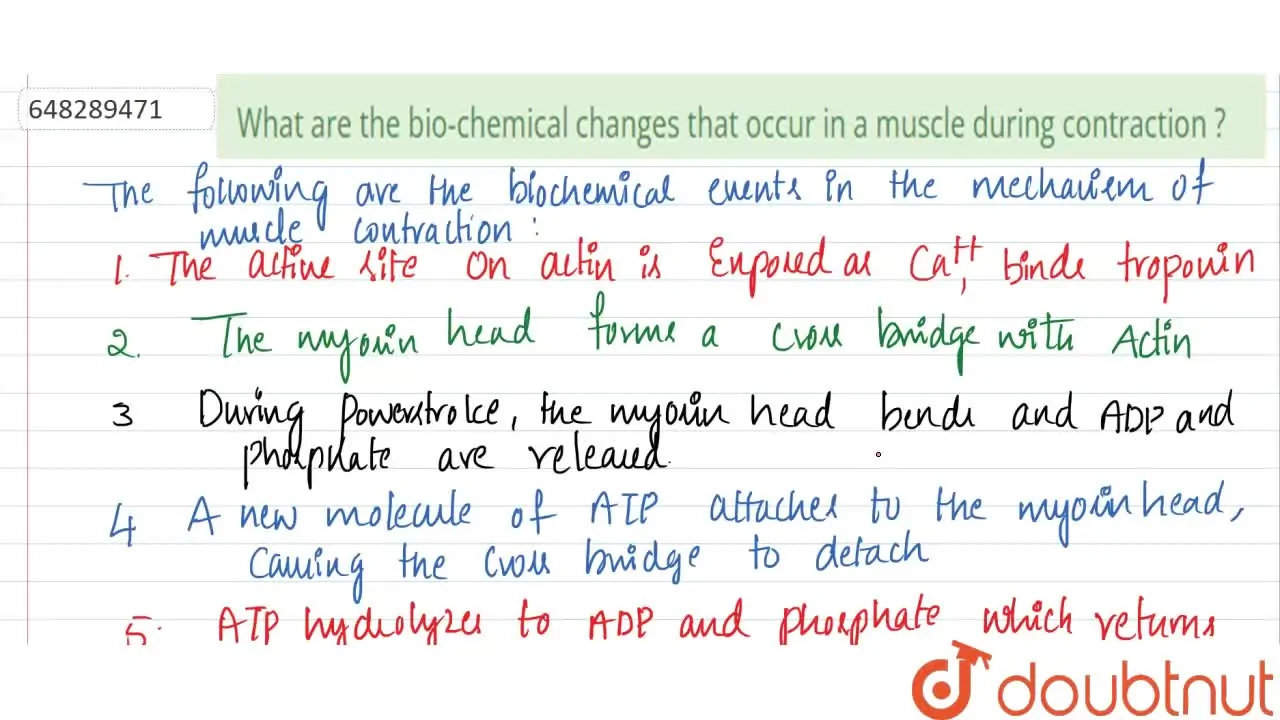What are the bio-chemical changes that occur in a muscle during contraction ?Solution in Telugu
For the contraction of muscle, continuous supply of energy is needed . ATP is the immediate source of energy for muscle contraction . As the ATP content is very low , it is actively replenished, continuously by an energy rich muscle phosphagen .
ATP→ADP+Π
The high energy phosphates of muscles that donate energy phosphate group to ADP are known as phosphagen . In vertebrate muscles creatine phsophate (CP) is the phsophagen, which is an immediate backup source . In invertebrate muscles, It is in the arginine phosphate . This reaction is catalysed by creatine kinase (CK) . Creatine Phosphate is the immediate additional source of energy in the muscle .
Creatine phosphate +ADP → Creatine
When creatine phosphate gets exhausted, the next source of reserve energy is utillised, which includes the oxidation of glucose and fatty acids . The energy liberated in this process is transferred to ADP and creatine . Thus ATP and creatine phosphate are formed and which in turn supply energy for muscle contraction .
During rapid activity of a muscle, the respiratory system is unable to supply sufficient oxygen needed by it, which leads to oxygen debt . It is defined as the amount of extra oxygen required by a muscle during recovery from vigorous exercise . Thus the pyruvic acid produced by glycolysis is transformed into lactic acid in the absence of oxygen . Accumulation of lactic acid in the muscle leads to muscle fatigue .
Lactic acid, formed in the anaerobic degradation in the muscle, reaches the liver through blood circulation . In liver, during rest, 80% of lactic acid is utillised in the resynthesis of glycogen, which is transported back to muscle . This is known as Cori cycle . 20% of lactic acid is oxidised as CO2 and H2O .
Related Playlists
- BOOK - VGS PUBLICATION-BRILLIANTCHAPTER - ZOOLOGY MODEL PAPER 13EXERCISE - Section-C3videos
ZOOLOGY MODEL PAPER 13
- BOOK - VGS PUBLICATION-BRILLIANTCHAPTER - ZOOLOGY MODEL PAPER 13EXERCISE - Section-C3videos
ZOOLOGY MODEL PAPER 13
- BOOK - VGS PUBLICATION-BRILLIANTCHAPTER - MOST IMPORTANT QUESTIONSEXERCISE - UNIT -VIII APPLIED BIOLOGY ( SHORT ANSWER TYPE QUESTIONS)9videos
MOST IMPORTANT QUESTIONS
- BOOK - VGS PUBLICATION-BRILLIANTCHAPTER - ZOOLOGY MODEL PAPER 14EXERCISE - Section-C3videos
ZOOLOGY MODEL PAPER 14
Similar Questions
How does human heart function topump blood to the body parts ?
01:23View SolutionHow does human heart function topump blood to the body parts ?
06:16View SolutionList out the various steps involved in MOET."
04:29View SolutionDescribe the structure of the heart of man with the help of neat labelled diagram.
01:53View SolutionDuring muscle contraction which of the following does not occurs ?
04:06View SolutionWhich of the following changes occur when a skeletal muscle contracts?
01:17View SolutionWhich of the following occurs during muscle contraction?
02:07View Solutionपेशियों के आकुंचन के समय कौन-सा पदार्थ बनता है ?
03:23View SolutionDuring muscle contraction , hydrolysis of ATP results in a change in the .
01:49View SolutionWho explained the biochemical changes occurring during muscle contraction?
01:51View SolutionBio chemical changes in muscle contraction were explained by ………….. .
03:17View SolutionDuring muscle contraction, all of the following occur except
03:16View SolutionList various chemical changes during muscle contraction.
02:49View SolutionWhat things are likely to occur, during a chemical change?
04:26View SolutionWhich of the following changes occurs when a skeletal muscle contracts?
01:11View SolutionWhich of the following occurs during muscle contraction?
02:56View Solution


